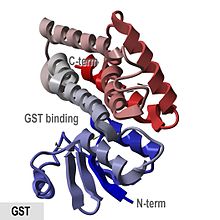Glutathione S-transferase
Glutathione S-transferases (GSTs), previously known as ligandins, comprise a family of eukaryotic and prokaryotic phase II metabolic isozymes best known for their ability to catalyze the conjugation of the reduced form of glutathione (GSH) to xenobiotic substrates for the purpose of detoxification. The GST family consists of three superfamilies: the cytosolic, , and microsomal—also known as MAPEG—proteins. Members of the GST superfamily are extremely diverse in amino acid sequence, and a large fraction of the sequences deposited in public databases are of unknown function. The Enzyme Function Initiative (EFI) is using GSTs as a model superfamily to identify new GST functions.
GSTs can constitute up to 10% of cytosolic protein in some mammalian organs. GSTs catalyse the conjugation of GSH — via a sulfhydryl group — to electrophilic centers on a wide variety of substrates in order to make the compounds more water-soluble. This activity detoxifies endogenous compounds such as peroxidised lipids and enables the breakdown of xenobiotics. GSTs may also bind toxins and function as transport proteins, which gave rise to the early term for GSTs, ligandin.
Protein sequence and structure are important additional classification criteria for the three superfamilies (cytosolic, mitochondrial, and MAPEG) of GSTs: while classes from the cytosolic superfamily of GSTs possess more than 40% sequence homology, those from other classes may have less than 25%. Cytosolic GSTs are divided into 13 classes based upon their structure: alpha, beta, delta, epsilon, zeta, theta, mu, nu, pi, sigma, tau, phi, and omega. Mitochondrial GSTs are in class kappa. The MAPEG superfamily of microsomal GSTs consists of subgroups designated I-IV, between which amino acid sequences share less than 20% identity. Human cytosolic GSTs belong to the alpha, zeta, theta, mu, pi, sigma, and omega classes, while six isozymes belonging to classes I, II, and IV of the MAPEG superfamily are known to exist.
...
Wikipedia


